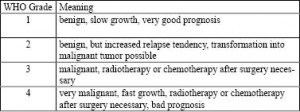Within the group of intracranial (inside the head) benign tumors, especially the so-called cerebellopontine angle tumor (acoustic neurinoma) and those of the meninx (meningeom) occur most frequently. They can be completely removed by microsurgery and, thus, are curable.
Within the group of malignant tumors, metastases are most frequently. The origin of metastases is parts from a primary tumor (e.g., lung or intestines) that have circulated through vessels and deposited in normal tissue. Primary tumors describe the tissue from which metastases orignate.
Besides abovementioned classifications, there are malignant primary tumors, the so-called glioma and astrocytoma. These are graded in terms of their malignancy: grade II to IV. Grade IV corresponds to the most severe and aggressive tumor, the glioblastoma. Healing is only possible in very few cases. The function of neuroradiology and neurosurgery here is to ensure the correct diagnosis (by differentiating it from diseases with similar symptoms which are potentially curable), to preserve quality of life and prolong life in general.
Besides the tumor grading, there is also a classification of the tumors of the central nervous system according to the WHO. You can watch or download it here.



